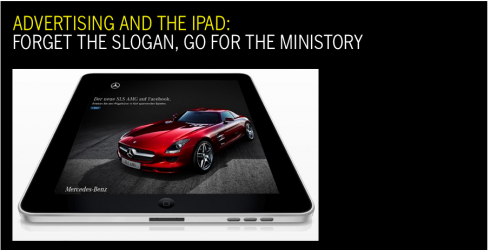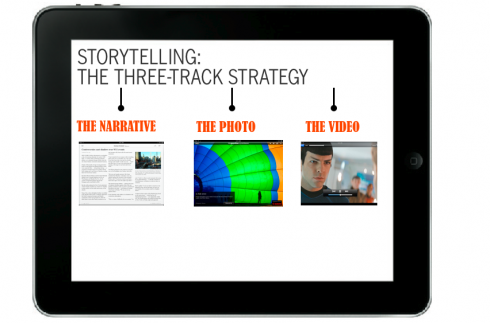TAKEAWAY: It was a day with iPads as protagonists—-and they were visible almost in front of everyone in the room. Having a conversation about advertising and the iPad with those in charge of creating it! The mini-story as advertising tool. AND: Planning the iPad app for your newspaper: storytelling and the three-track sequence
Different game for advertising in the iPad

It was interesting to address a group of Austrian advertising and marketing managers Tuesday in Vienna—-they are the ones who allocate advertising to the various media. For them, the new challenge is that of the tablets,and, for the moment, the iPad, which is making its incursion into Austria quite nicely.
Just before I went into that session, I had read a rather impressive statement in Madrid’s El Pais about the iPad. In a Sunday edition section about technology, titled “idea laboratory”, a writer from Reuters Breakingviews, Robert Cyran, wrote: “The iPad is already showing that it is on its way to becoming the most rapidly accepted commercial product in history”.
I don’t doubt this at all, and the people I talk to on a daily basis are a testimony to the impact that the iPad is having on their work and lives.
In fact, yesterday morning, as I waited in Amsterdam to board my flight to Vienna, I paid a visit to the KLM Lounge and, surprise, they now have “iPad islands” in the middle of the giant lounge there, very similar to what you would find at an Apple store: the iPads are chained to their stations, ready for passengers to use. This, I suggest, should become a feature of airline lounges everywhere!
The advertising iPadistas
The iPad island at KLM”s passenger lounge in Amsterdam
There they sat, about 15 of Austria’s advertising/marketing managers, the ones who manage the major media advertising accounts. More than half had an iPad in front of them, which they used to take notes during my presentation.
It was my first time addressing a group whose main interest in the iPad is purely about advertising.
What were the key questions and issues?
As it happens everywhere, a main issue is the fact that clients are not necessarily preparing advertising specifically customized for the iPad. So, they asked, what are we to do if we want to have advertising that is more geared towards this new platform?
My suggestion: Get your creative people to start developing advertising that fits into the usability patterns that we now know are prevalent among iPad users.
And, I may add, this will require a high level of creativity, and, in a sense an abandoning of the old style advertising campaign strategies.
It is no longer about creating a phrase or slogan and splashing it on the page, or the TV screen. Phrases that have stayed with us like “American Express: don’t leave home without it”, or “Coke is it” may play well in other platforms, but the iPad, which we now know to be a relaxing platform, is more about creating an ambience, involving the user in a more intimate relationship with the advertising and its message. I believe that advertising in the tablets will be more about weaving little stories together, whether you are selling a car, an insurance company or an airline.
I believe that there will be more use of photography, and that we will want to explore photos that sell a given product beyond one single message and more into the mini stories that tell us details that are visible on the photo.
Fingers are curious on the iPad screen.
Great opportunity for the creative to tell short, all inclusive mini stories that sell.
In the newsroom: planning the content of the iPad app

My afternoon in Vienna was inside the newsroom of Wirtschafts Blatt, the financial daily, where already an iPad app exists, and one that has been welcomed with great success. There are about 10,000 iPad users in Austria, according to unofficial estimates.
Our workshop this afternoon is to start thinking of the next version of the WB iPad app, one that may take them perhaps from a mere e reader type of environment, flipping page by page, to one that is more customized as its own edition.
An important topic of discussion, the “pop up” concept, the term I use to describe that one story where the editor uses the potential of the iPad to give a story longer legs.
We talk about taking a story about a CEO for example, to the next level, and I diagram the “three track concept” for the story; the narrative has a strong place, of course, it is at the heart of the presentation, but so is a gallery of photos that may, in turn, lead to some video. Storytelling at three different levels.
I maintain that the iPad allows for reading of longer pieces, as it is a more relaxing medium, but one must make sure to explore the potential of this platform to go beyond just the reading of text.
Perhaps not for every story, of course, and, as in the case of the WB, and this is what we do at this workshop, an effort that may start with weekend editions, where there is more time to prepare for three-track presentations.
But the three track presentation is the goal, storytelling adding legs to the story.
Incidentally, when the question came up at this workshop as to the number of new hires required to do a proper app: I don’t deal with numbers, as each situation is different, but, for sure, you need two key people: an editor dedicated to the iPad edition, and a good photo editor. If a third person is available, make that one a multimedia editor.